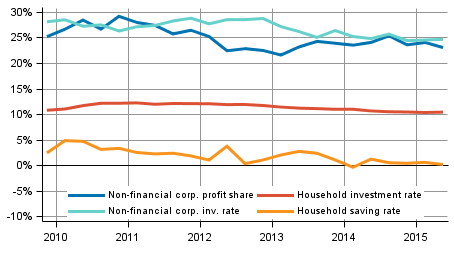Published: 23 September 2015
Households' saving rate contracted in the second quarter of 2015
Households' saving rate diminished slightly in the second quarter, because the households sector's disposable income contracted while consumption expenditure remained unchanged. Adjusted disposable income describing households' economic well-being grew slightly year-on-year. The profit share of the non-financial corporations sector weakened compared to the previous quarter as the sector's expenditure on wages and salaries grew more than value added. The investment rate of non-financial corporations was slightly higher than in the previous quarter. These data derive from Statistics Finland’s quarterly sector accounts.
Key indicators for households and non-financial corporations, seasonally adjusted

In the second quarter of 2015, the profit share of non-financial corporations, or the share of the operating surplus describing profits in value added, weakened by one percentage point to 23 per cent. The investment rate of non-financial corporations, or the proportion of investments in value added, was slightly higher than in the previous quarter at 24.6 per cent. The key figures were calculated from seasonally adjusted time series.
Households' saving rate was 0.1 per cent in the second quarter of 2015. In the previous quarter, the figure was 0.5 per cent. The saving rate refers to the proportion of savings in disposable income. In the second quarter, the investment rate of households accounted for 10.4 per cent of disposable income. The investment rate of households has not changed significantly during the past year. Most of households' investments were investments in dwellings.
Households' adjusted disposable income was almost on level with the corresponding period of last year, growing by 0.3 per cent adjusted for price changes. Adjusted income is the indicator recommended by the OECD for evaluating the economic well-being of households. Adjusted disposable income is derived by adding individual services produced by the public sector, such as education, health and social services, to the disposable income of households.
Sector accounts are calculated only at current prices. However, a volume indicator describing the development adjusted for price changes is calculated for households' adjusted disposable income in a separate Appendix table. The profit share, saving rate and investment rate are calculated from net figures, which means that consumption of fixed capital is taken into account. Households do not include non-profit institutions serving households.
Source: Sector accounts, Statistics Finland
Inquiries: Jesse Vuorinen 029 551 3363, Katri Soinne 029 551 2778, kansantalous.suhdanteet@stat.fi
Director in charge: Ville Vertanen
Publication in pdf-format (368.6 kB)
- Reviews
- Tables
-
Tables in databases
Pick the data you need into tables, view the data as graphs, or download the data for your use.
Appendix tables
- Figures
-
- Appendix figure 1. Volume development of households adjusted disposable income (23.9.2015)
- Appendix figure 2. Households saving rate (23.9.2015)
- Appendix figure 3. Households investment rate (23.9.2015)
- Appendix figure 4. Non - financial corporations profit share (23.9.2015)
- Appendix figure 5. Non - financial corporations investment rate (23.9.2015)
- Revisions in these statistics
-
- Revisions in these statistics (23.9.2015)
Updated 23.9.2015
Official Statistics of Finland (OSF):
Quarterly sector accounts [e-publication].
ISSN=2243-4992. 2nd quarter 2015. Helsinki: Statistics Finland [referred: 16.4.2024].
Access method: http://www.stat.fi/til/sekn/2015/02/sekn_2015_02_2015-09-23_tie_001_en.html

